If you live in Bangalore, hacked limbs of trees piled up by the roadside are commonplace. Avenues once drenched in the deep, dense shade of tree canopies are today rubble strewn, choking with traffic. Trees that have been part of our cityscape and memories for decades are suddenly found butchered to death and heaped together in mangled heaps.
The residential areas as also the arterial roads connecting the cities have been systematically denuded of their green cover. And no amount of green marathons, reassuring newspaper statements issued by Bruhat Bengaluru Mahanagara Palike (Greater Bangalore Municipal Body) or any other government mouthpiece can take away from the fact that Bangalore is no longer a garden city.
It is a skeletal city with a dying spirit that derived much of its restfulness from its rooted, flowering, shady co-inhabitants. Sometime in January this year, a newspaper reported that ‘development’ (for whose benefit, you may ask and that is another debate for another time) projects have eaten into the once abundantly green residential areas and the notified forest area in the city limits is just two per cent. The Forest Survey of India, in the forest report (2009), said that the Bangalore district forest cover is only around 6.80 per cent.
I may have quoted these statistics before but everyday I see or hear of a lung space being appropriated by officious bull dozers, brazen tree choppers, builders, without any regard for the citizens in whose supposed interests this devastating progress is being initiated. Kanakapura Road where my son’s first school was situated, had mature, full-grown shady trees and they are all gone.
Just today, a friend frantically posted a message on Facebook to ask if the island garden flanking Mayo Hall is being taken apart. The citizens in the meanwhile are expected to sigh, mourn in silence and move on with their lives and get used to the idea of a city without shade. It is still tough for the majority of us to acknowledge that trees are part of our living heritage and integral to the identity of a city like Bangalore and to its sense of well-being. And the day, the cutting of even a single tree becomes a personal issue for each one of us, it will become a political issue too and then things will change. The change will begin however when the citizens stand up and be counted, not just in Bangalore but in any place where the fundamental right to green cover, is threatened.
There is no precedent more inspiring than the Chipko movement of the early 1970s that brought back the national spotlight on the deforestation of the Garhwal Himalayas of Uttarakhand. It is now a historical reference point for all green warriors that on March 26, 1974, a few peasant women in Reni village, Hemwalghati, in a symbolic gesture of asserting their forest rights, stood up to the contractors in the region by hugging trees to protect them.
In a country where trees were at one point worshipped as living deities, the roots of Chipko movement go as far back as in 1730 AD when in a village in Rajasthan, a handful of Bishnois (yes, the same who made sure that even a powerful celebrity like Salman Khan was made to answer for the killing of a black-buck) gave up their lives trying to protect khejri trees.
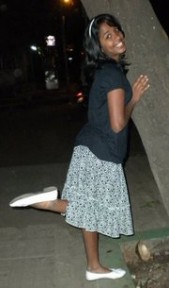 “You may have seen a fallen tree but when you actually see a tree fall…the way it screams helplessly.. it is the saddest thing. And its sickening how mercilessly the tree cutters hack living branches,” says Anagha N Bharadwaj, a 16 year old student (left), the youngest green activist among many others who a few days ago, gathered along Sankey Tank Road to protest its widening and the imminent death of many mature, sturdy trees.
“You may have seen a fallen tree but when you actually see a tree fall…the way it screams helplessly.. it is the saddest thing. And its sickening how mercilessly the tree cutters hack living branches,” says Anagha N Bharadwaj, a 16 year old student (left), the youngest green activist among many others who a few days ago, gathered along Sankey Tank Road to protest its widening and the imminent death of many mature, sturdy trees.
And young Anagha discovered what many of us take quite a few knocks to register. That the law of the land benefits those who have the axe. She along with many volunteers saw first hand the dismissive, almost ruthless manner in which the authorities first arrested some prominent protesters like Dr Meenakshi Bharath, dragged a woman activist (Victoria D’Souza) over stones and broken glass pieces (recounts Anagha) and then accorded police protection to tree cutters to come back in the dead of the night and finish what they had started.
17 trees were cut by the BBMP despite young and old citizens begging and trying to protect them from officials who are supposed to act in the best interests of the city. The irony! Says Anagha, “If things continue like this, one day, perhaps, I will have to go camping in my backyard because there will be no green spaces anywhere. And because there will no trees, there won’t be enough oxygen either and we will have to carry oxygen cylinders.”
What is even more galling that BBMP not just secretly auctioned some of the trees but brazenly went ahead with the felling even as the hearing on the public interest litigation (PIL), filed by Dr Meenakshi Bharath and five other citizens, was going on in the High Court. Dr Bharath was arrested along with 12 other protesters, including environmentalist Suresh Heblikar and Vinay Srinivasa and then detained by the police.
Peacefully protesting citizens were ostensibly taken into “preventive” custody but charges initially included 353 (assault or criminal force to deter public servant from discharge of his duty), Sections 143 and 149 (punishment for unlawful assembly) and were dropped only after the intervention of the Police Commissioner Jyothi Prakash Mirji. The pic above shows the citizens mourning the trees after they were felled.
Says Anagha, “They came with manpower, muscle power to make sure the trees were cut. Do you know that in the last three years, 7000 trees have been cut in just Bangalore? There were so many trees of so many species and such ecological diversity..how can that be recreated? The ficus is the only tree on which migratory birds come and rest. The sparrows are gone from Bangalore and now the migratory birds will too because very soon there will be no ficus left. And even though I don’t believe in Doomsday predictions, I believe if things go on like this, the world will end before 2012. By taking away our forests and trees, powerful people around the world are passing on to the young, a dying planet.”
She points out many instances in the city where shady avenues have been destroyed to make multi-lane roads congested with traffic. Or some lanes are used for parking. She asks, “Do we need cars more than we need trees?”
The citizens who saw this wilful felling know that they are up against deep rooted corruption. And even a 16-year old like her can see that projects are taken up and then left incomplete but the only thing complete is the destruction of Bangalore’s lung spaces.
A Facebook group Save Trees. Save Bangalore has been formed to continue the citizen initiative against similar attacks on the green cover. And this is what its members have to say/ask about events at the Sankey Road.
Is there a mafia, a strong lobby benefitting from tree cutting around the city?
Do we need superways instead of residential layouts?
Do we need Sankey tank or another mall in its place?
Following the high court stay order cutting down trees at Sankey Road and despite severe protests from NGOs over the chopping of trees on Sankey Tank Bund Road, the BBMP managed to cut 17 out of the 19 proposed trees.
Now the protesters seek suspension of Deputy Conservator of Forests (DCF) Puttaswamy for the irregularities in the auction and felling process.
BBMP is violating the Karnataka Town and Country Planning Act and Karnataka Tree Preservation Act. Such actions are also in absolute contempt of the directions of the High Court.
On Wednesday last, Puttaswamy attempted to auction trees on Sankey Road. But due to public protest, the auction was called off and the demand drafts deposited by bidders were returned. But on June 30, evening, news spread that Puttaswamy was planning to fell trees at night.
Leo Saldanha, coordinator of an environment support group, contacted Puttaswamy and urged him to abandon the exercise of tree felling on Sankey Road. Saldanha then contacted BBMP commissioner Siddaiah and briefed him about the situation.
However, on Friday noon, Puttaswamy hired workers and cut the trees. When the members rushed to protest and stop the felling, the police blocked them and threatened dire action. By the early hours of morning, at least four fully-grown trees had been felled (pic above). Some of the protesters recounted the horror of the proceedings in this video https://www.youtube.com/watch?v=6vExlbAbfx0&feature=player_embedded#at=521
A Facebook group Save Trees. Save Bangalore has been formed to continue the citizen initiative against similar attacks on the green cover.
Bangaloreans are invited to join a silent protest at 8 am on Sunday (10th June) morning at Sankey Tank. Even if the protest is silent, the message to the powers-that-be is clear.
Bangalore, or atleast some of its citizens will make noise, inconveniently and persistently to reclaim, mourn and stand up for a city that was once green.
For more details, join or visit
http://www.facebook.com/home.php?sk=group_220078971356960
All pictures courtesy Anagha, Vani Murthy and the members of Save Trees. Save Bangalore initiative.
Reema Moudgil is the author of Perfect Eight (http://www.flipkart.com/b/books/perfect-eight-reema-moudgil-book-9380032870?affid=unboxedwri )






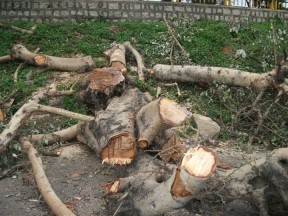
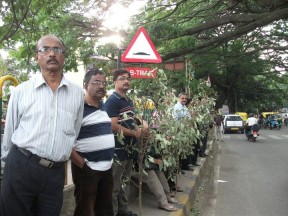
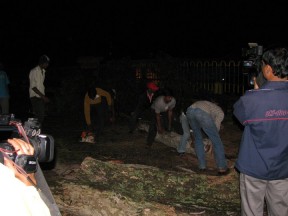
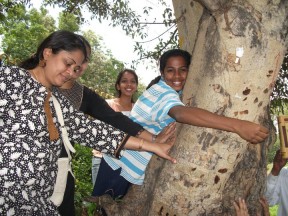
like amputated limbs…
a heart breaking sight.
all the very best to all of you working to save the trees.